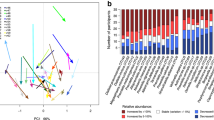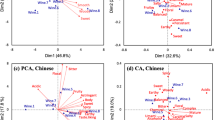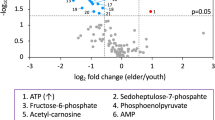Abstract
In the pathophysiological context of obesity, oral exposure to dietary fat can modulate lipid digestion and absorption, but underlying in-mouth mechanisms have not been clearly identified. Therefore, we tested the hypothesis that salivary components related to dietary fat sensitivity would differ according to body mass index (BMI) and postprandial lipid metabolism in young men. Saliva was collected from nine normal-weight (BMI=22.3±0.5 kg m−2) and nine non-morbid obese (BMI=31.7±0.3 kg m−2) men before an 8-h postprandial metabolic exploration test involving the consumption of a 40-g fat meal, in which obese subjects revealed a delayed postprandial lipid metabolism. Nine salivary characteristics (flow, protein content, lipolysis, amylase, proteolysis, total antioxidant status, lysozyme, lipocalin 1 and carbonic anhydrase-VI) were investigated. We show that, under fasting conditions, salivary lipolysis was lower in obese vs normal-weight subjects, whereas proteolysis and carbonic anhydrase VI were higher. We reveal through multivariate and Mann–Whitney analysis that differences in fasting salivary lipolysis and proteolysis between both groups are related to differences in postprandial lipid metabolism including exogenous fatty-acid absorption and β-oxidation. These results suggest a potential role of salivary composition on postprandial lipid metabolism and bring novel causal hypotheses on the links between salivary composition, sensitivity to dietary fat oral income and postprandial lipid metabolism according to BMI.
This is a preview of subscription content, access via your institution
Access options
Subscribe to this journal
Receive 12 print issues and online access
$259.00 per year
only $21.58 per issue
Buy this article
- Purchase on Springer Link
- Instant access to full article PDF
Prices may be subject to local taxes which are calculated during checkout

Similar content being viewed by others
References
Vors C, Pineau G, Gabert L, Drai J, Louche-Pelissier C, Defoort C et al. Modulating absorption and postprandial handling of dietary fatty acids by structuring fat in the meal: a randomized crossover clinical trial. Am J Clin Nutr 2013; 97: 23–36.
Mattes RD . Is there a fatty acid taste? Annu Rev Nutr 2009; 29: 305–327.
Spielmann N, Wong DT . Saliva: diagnostics and therapeutic perspectives. Oral Dis 2011; 17: 345–354.
Mandel AL, Breslin PAS . High endogenous salivary amylase activity is associated with improved glycemic homeostasis following starch ingestion in adults. J Nutr 2012; 142: 853–858.
Feron G, Poette J . In-mouth mechanism leading to the perception of fat in humans: from detection to preferences. The particular role of saliva. OCL 2013; 20: 102–107.
Sarkar A, Singh H Oral behaviour of food emulsions In: Chen J, Engelen L(eds) Food Oral Processing. Wiley-Blackwell: UK: UK, 2012. pp 111–137.
Mounayar R, Septier C, Chabanet C, Feron G, Neyraud E . Oral fat sensitivity in humans: links to saliva composition before and after stimulation by oleic acid. Chemosens Percept 2013; 6: 118–126.
Mounayar R, Morzel M, Brignot H, Tremblay-Franco M, Canlet C, Lucchi G et al. Salivary markers of taste sensitivity to oleic acid: a combined proteomics and metabolomics approach. Metabolomics 2013; 1–9.
Neyraud E, Palicki O, Schwartz C, Nicklaus S, Feron G . Variability of human saliva composition: possible relationships with fat perception and liking. Arch Oral Biol 2012; 57: 556–566.
Benjamini Y, Hochberg Y . Controlling the false discovery rate: a practical and powerful approach to multiple testing. J R Stat Soc Ser B 1995; 57: 289–300.
Piombino P, Genovese A, Esposito S, Moio L, Cutolo PP, Chambery A et al. Saliva from obese individuals suppresses the release of aroma compounds from wine. PLoS One 2014; 9: e85611.
Chong IG, Jun CH . Performance of some variable selection methods when multicollinearity is present. Chemom Intell Lab Syst 2005; 78: 103–112.
Schiffman SS, Dackis C . Taste of nutrients—amino-acids, vitamins, and fatty-acids. Percept Psychophys 1975; 17: 140–146.
Dsamou M, Palicki O, Septier C, Chabanet C, Lucchi G, Ducoroy P et al. Salivary protein profiles and sensitivity to the bitter taste of caffeine. Chem Senses 2012; 37: 87–95.
Bartoshuk LM, Duffy VB, Hayes JE, Moskowitz HR, Snyder DJ . Psychophysics of sweet and fat perception in obesity: problems, solutions and new perspectives. Philos Trans R Soc B 2006; 361: 1137–1148.
Stewart JE, Feinle-Bisset C, Keast RSJ . Fatty acid detection during food consumption and digestion: associations with ingestive behavior and obesity. Prog Lipid Res 2011; 50: 225–233.
Chevrot M, Passilly-Degrace P, Ancel D, Bernard A, Enderli G, Gomes M et al. Obesity interferes with the orosensory detection of long-chain fatty acids in humans. Am J Clin Nutr 2014; 99: 975–983.
Tucker RM, Edlinger C, Craig BA, Mattes RD . Associations between BMI and fat taste sensitivity in humans. Chem Senses 2014; 39: 349–357.
Stewart JE, Seimon RV, Otto B, Keast RS, Clifton PM, Feinle-Bisset C . Marked differences in gustatory and gastrointestinal sensitivity to oleic acid between lean and obese men. Am J Clin Nutr 2011; 93: 703–711.
Keller A, Rohde JF, Raymond K, Heitmann BL . The association between periodontal disease and overweight and obesity: a systematic review. J Periodontol 2015; 20: 1–15.
Acknowledgements
CV acknowledges her PhD grant from INRA and CNIEL. GF thanks the Burgundy Regional Council for funding. MCM thanks CNIEL for funding the clinical trial. We thank Hélène Brignot for technical assistance. Yvonne Masson is acknowledged for revising the English language. We thank the volunteers and the team of CRNH-RA for their involvement. This work was supported by the Institut National de la Recherche Agronomique (INRA), the Burgundy Region (The Regional Council) and the Centre National Interprofessionnel de l’Economie Laitière (CNIEL).
Author information
Authors and Affiliations
Corresponding author
Ethics declarations
Competing interests
The authors declare no conflict of interest.
Rights and permissions
About this article
Cite this article
Vors, C., Drai, J., Gabert, L. et al. Salivary composition in obese vs normal-weight subjects: towards a role in postprandial lipid metabolism?. Int J Obes 39, 1425–1428 (2015). https://doi.org/10.1038/ijo.2015.71
Received:
Revised:
Accepted:
Published:
Issue Date:
DOI: https://doi.org/10.1038/ijo.2015.71
This article is cited by
-
A comparative pharmacogenomic analysis of three classic TCM prescriptions for coronary heart disease based on molecular network modeling
Acta Pharmacologica Sinica (2020)
-
Obese Subjects With Specific Gustatory Papillae Microbiota and Salivary Cues Display an Impairment to Sense Lipids
Scientific Reports (2018)
-
Lipids and obesity: Also a matter of taste?
Reviews in Endocrine and Metabolic Disorders (2016)
-
Carbonic Anhydrase VI Gene Polymorphism rs2274327 Relationship Between Salivary Parameters and Dental-Oral Health Status in Children
Biochemical Genetics (2016)



